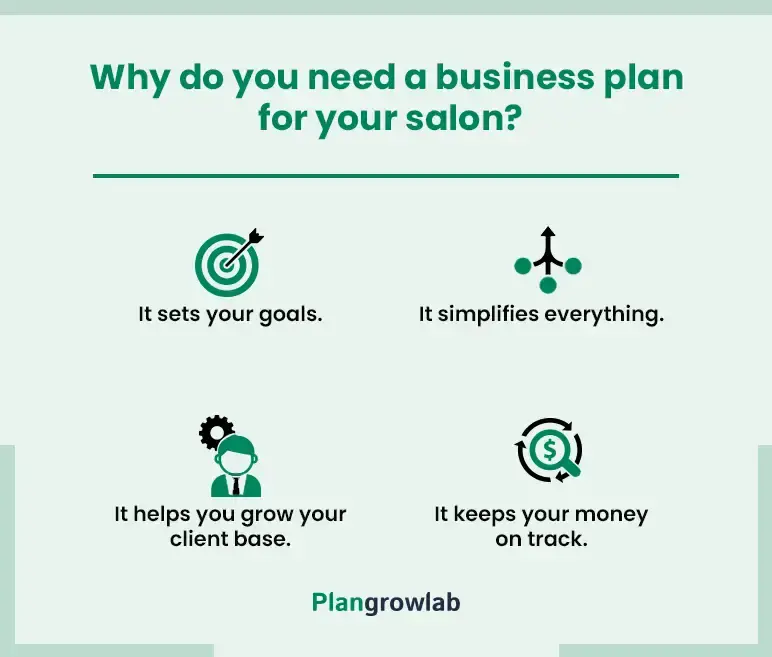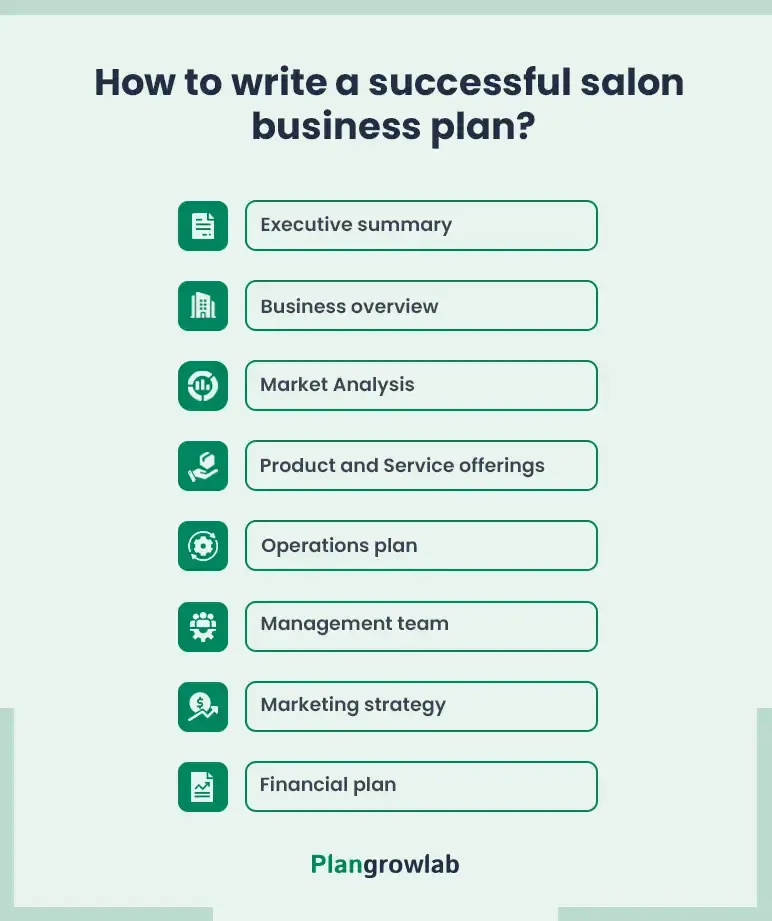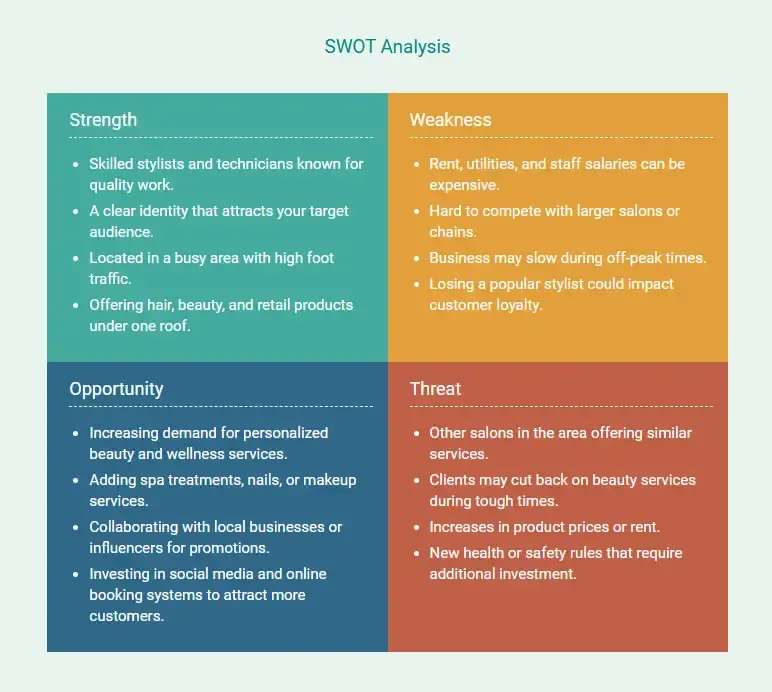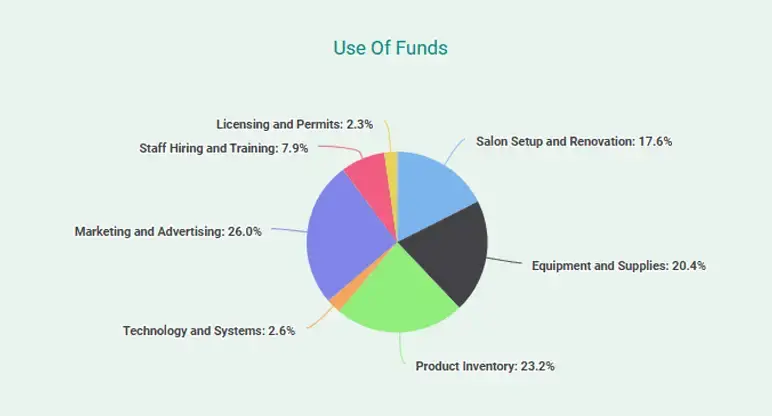Starting a salon business? Sounds like a great idea, right? The beauty industry is thriving, and there’s definitely room for growth. But here's the thing: without a solid business plan, things can get pretty hectic.
I recently spoke with Jennifer Paschke, who owns “Touch Salon & Spa”. She told me how having a business plan has made all the difference for her.
It helped her stay on top of everything and really focus on her long-term goals.
From those insights, I’ve prepared this guide to help you know how to create a successful salon business plan easily.
Why do you need a business plan for your hair salon?
A good business plan helps you stay focused, organized, and clear on what you’re doing and why.

Here’s why it’s so important:
- It sets your goals: You’ll know exactly where you’re headed and what you need to do to get there.
- It keeps your money on track: You’ll have a better handle on costs, pricing strategy, and making sure you’re making a profit.
- It helps you grow your client base: You’ll figure out who your target customers are and the best ways to attract them.
- It simplifies everything: From running the salon to managing marketing, a plan keeps you organized and avoids unnecessary stress.
At the end of the day, a business plan isn’t just paperwork—it’s your guide to making your salon a success and keeping things running smoothly without the guesswork.
How to write a hair salon business plan?
Here’s a list of key elements to include in your hair salon business plan and learn how to write a detailed plan:

1. Executive summary
The executive summary is basically the intro to your whole salon business plan.
Think of it like a trailer for your hair salon—it’s short, to the point, and gives people a quick idea of what’s inside.
It’s only about 10% of the plan, but it covers all the key details.
Here’s what to Include in your executive summary:
- Salon name & location – Where your salon is based and what it’s called.
- Business concept – The type of salon you’re opening and the services you’ll offer.
- Target market – Who your ideal customers are and what makes them a good fit for your salon.
- Competitive advantage – What sets your salon apart from others in the area.
- Financial highlights – A brief overview of expected costs, revenue projections, and profitability.
- Business goals – Your short-term and long-term goals for the salon.
In short, your plan summary is the most important part because it’s the first thing people will read, and you want to make a great impression.
“When I sat down to write my first executive summary, I had no idea where to start.
I kept trying to include everything—my services, target market, and financial projections. But I quickly realized the executive summary isn’t the place for every little detail—I needed to keep it focused.
So, I highlighted the essentials: my experience in the salon industry, the successful client base I’ve built, and how my approach to customer service and trend-focused styling sets my salon apart.
Once I stopped overthinking and left the finer details for the rest of the plan, everything came together much more easily.”—Jennifer Paschke
2. Business overview
This is where you share how your hair salon is set up and what direction you’re headed in.
It's very important for any person who may be interested in investing or partnering with you. They’ll want to know how your business operates and where you’re going to take it.
So, consider including the following key elements while drafting this section:
- Business structure: So, how’s your salon set up? Is it just you running the show, or do you have partners? Are you an LLC or something else? This gives a peek into how your hair salon works behind the scenes.
- Mission statement: What’s the purpose of your salon? Why did you start it, and what big business objectives are you working toward? Let people know what drives you.
- Ownership & management: Who owns the hair salon, and who’s handling the daily tasks? This part helps others understand who’s making decisions and running the day-to-day.
- Short-term and long-term business goals: What are you hoping to achieve in the next year or two? And where do you see your hair salon in 5 or 10 years?
“Writing the business overview helped me define what the hair salon is really about. I understood that it is not just a place to get hair done—it’s a space where people can relax, feel confident, and enjoy personalized care.
I focused on highlighting our welcoming atmosphere, our mission statement, and how we’d cater to the needs of the community.
Once I thought of it as telling our story, it all came together.”—Jennifer Paschke
3. Market analysis
The market analysis is the most significant part of your beauty salon business plan. When you do it right, it tells investors, partners, and stakeholders that you really understand the target market you’re entering.
Think of it as your opportunity to demonstrate that you know what is happening in the hair salon industry and how your salon fits into that bigger picture.
Begin by defining your ideal customers—who they are, where they are, and what type of buyers they are. Show how your hair salon addresses particular pain points in the market and aligns with customer preferences, setting your business apart.
Building a loyal client base will be key to sustaining long-term growth in this competitive industry.
Further, highlighting a strong SWOT analysis can reinforce your understanding of your salon’s strengths, weaknesses, opportunities, and threats in the market. For Instance:

Finally, identify your competitors. Who else offers similar services, and how does your hair salon differentiate itself? Explain your positioning in the market relative to them.
“Market analysis was kind of overwhelming in the beginning. There are just so many salons around, so I had to understand what would differentiate us.
I spoke to the people in the area, and most of them said they needed eco-friendly products and more flexible appointment times.
That gave me a clear direction—listen to what people want and build your business around it.”—Jennifer Paschke
4. Product and service offerings
The products and services section is where you get to explain what your hair salon offers and why it’s so important. Focus on how your high-quality services appeal to your audience and encourage new clients to try your hair salon.
Here’s what you need to cover in this section:
- What high-quality products and services do you offer?
- Who are they for?
- Where can people get them?
- When can they book?
- How do they get the best results?
- What makes your services valuable?
Basically, this is your chance to show how your hair salon’s services hit the mark for your customers. Focus on what makes your services valuable and how they help you retain customers by building trust and loyalty.
“Deciding on the products and services was actually harder than I thought. I wanted to offer everything—cuts, coloring, facials, nails—but I realized I had to start small and focus on what we could do best.
I prioritized haircuts and styling, then added extras like bridal packages and treatments. My advice? Start with your strengths and grow from there.”—Jennifer Paschke
5. Operations plan
Your operational plan should detail how your hair salon will run day-to-day.
This will help you showcase the potential investors and partners that you’ve thought about the real, day-to-day work behind your hair salon. You’re not just dreaming; you have a clear plan to make it all work.
To keep it simple, here’s how to structure this section:
- Where’s your salon going to be? Is it a physical space, or are you offering online services?
- What tools are you using? Do you have a booking system, hair salon management software, or anything else that helps things run smoothly?
- Who’s helping you behind the scenes? Think about your suppliers or partners. Why did you pick them?
- How will you manage variable costs? What’s your plan to keep expenses in check and make sure everything runs efficiently?
“Planning out how the hair salon would run day-to-day took some time. I had to figure out everything—staff schedules, supply orders, and even how to handle double bookings.
Investing in a good appointment system really solved a lot of headaches.”—Jennifer Paschke
6. Management team
The management team of your business plan is super important—it’s what will grab the attention of your stakeholders.
By including this section, they’ll get a clear picture of how your salon is organized and who’s in charge. It’ll help them understand:
- How many people are on your team?
- What roles does each team member play?
- Who holds which position in the hair salon?
- How the team will work together to move the business forward.
- What experience does each person bring to the table?
If you have advisors or mentors, introduce them as well. Their experiences can add credibility and illustrate to investors that your team has access to valuable insight and guidance.
When all these can be visibly placed on the table, stakeholders will gain confidence in your business.
“The management team section was one of my favorites. It’s where I got to show off the people who are the backbone of this business.
Highlighting their skills and passion wasn’t just for investors—it was a reminder of the incredible team we’ve built.”—Jennifer Paschke
7. Marketing strategy
This is a major section in your business plan as it explains how you’re going to acquire customers and then make profits.
To plan this section, outline your strategies for increasing revenue and detail how much profit you expect from your marketing efforts.
The following are a few key factors that you need to cover:
- Target audience: Who are your ideal customers, and what do they need from your hair salon?
- Marketing channels: Where will you reach your audience—social media, email, or in-person events?
- Unique tactics: What will make your hair salon stand out, like referral and loyalty programs or special offers?
- Sales funnel: How do customers go from learning about you to booking an appointment?
“My hair salon marketing plan was all about getting people to notice us. I planned to use Instagram for sharing transformations and promotions, and I partnered with local influencers to spread the word.
It took some time to build a following, but offering discounts for first-time clients really helped.
So, try to be consistent—social media works, but only if we stick with it.”—Jennifer Paschke
8. Financial plan
Investors want to know the essentials: how much funding you need, how your hair salon will make money, and projections for future revenue.
The truth is, your financial plan isn’t just a formality; it’s your chance to prove you’ve got a clear path forward and highlight your salon’s financial viability to potential investors.
While crafting your salon financial plan, you should consider the following factors:
- Explain how your hair salon will make money. Will your revenue come from services, product sales, memberships, or a mix? Spell it out.
- Lay out your finances. Share your income statement, cash flow statement, and balance sheet so investors can see exactly where you stand financially.
- Set clear profitability business goals. Let them know when you expect your hair salon to start turning a profit—after covering all the anticipated expenses and how a strategy to retain customers will support steady revenue growth."
Besides that, specify your funding requirements. Are you seeking funding through a loan, angel investors, or venture capital? Explain how you’ll use the funds and how you plan to pay it back or share equity.

Overall, make your financial plan clear, show profitability, and gain investor trust—it’s the key to securing funding.
“Initially financial planning was very tough for me and I have made many mistakes that lead to some amount of loss in my business. But when I got to know about financial planning software from one of my friends, everything changed.
That tool helped me manage all my expenses and income and I also got a forecast for the next 5 years as per my current data.”—Jennifer Paschke
Download the free hair salon business plan template
Ready to start drafting your beauty salon business plan but not sure where to begin? Don’t worry, we’ve got you covered! You can download our free hair salon business plan template PDF to get started.
This template has helped thousands of hair salon owners get their businesses off the ground, and we hope it helps you too. Use it as a guide while you write your own business plan and customize it to fit the unique needs of your hair salon.
Get help writing your business plan
Let’s wrap this up! With this guide and our free template, you’re all set to start drafting your own plan.
But if you’re feeling stuck or need expert advice to perfect your plan, consider working with a top-notch business plan consultant. They’ll help you refine your plan and make sure it’s ready to impress investors.
So, don’t wait—reach out to the experts and get started today!
Frequently Asked Questions
What should you include in your hair salon business plan?
Your business plan should include:
- Executive summary
- Company description
- Market analysis
- Competitive analysis
- Products and services offered
- Marketing strategies
- Operations plan
- Management team
How much does a hair salon business plan cost?
The cost can range from $7 (or free) to $5,000 or more, depending on how you create it.
DIY templates are affordable while hiring professional writers or using business plan software can increase costs but provide a polished and comprehensive plan.
How to get funding for your beauty salon business plan?
If you need funding, a solid business plan is key. Here’s how to secure financial support:
- Decide how much funding you need and what it covers.
- Show market research that supports your salon’s potential.
- Highlight your edge and explain what makes your salon unique.
- Create financial projections, including income statements, cash flow estimates, and profit projections.
- Pick a funding option SBA/Bank Loans, Investors, Crowdfunding/Grants
- Present a solid plan. Keep it professional and investor-ready.
What are common mistakes to avoid in a hair salon business plan?
Here are some common mistakes to avoid in a solid plan:
- Overly optimistic financial projections
- Lack of clear target market analysis
- Ignoring operational details
- Failing to include a solid marketing strategy
- Skipping competitor analysis

